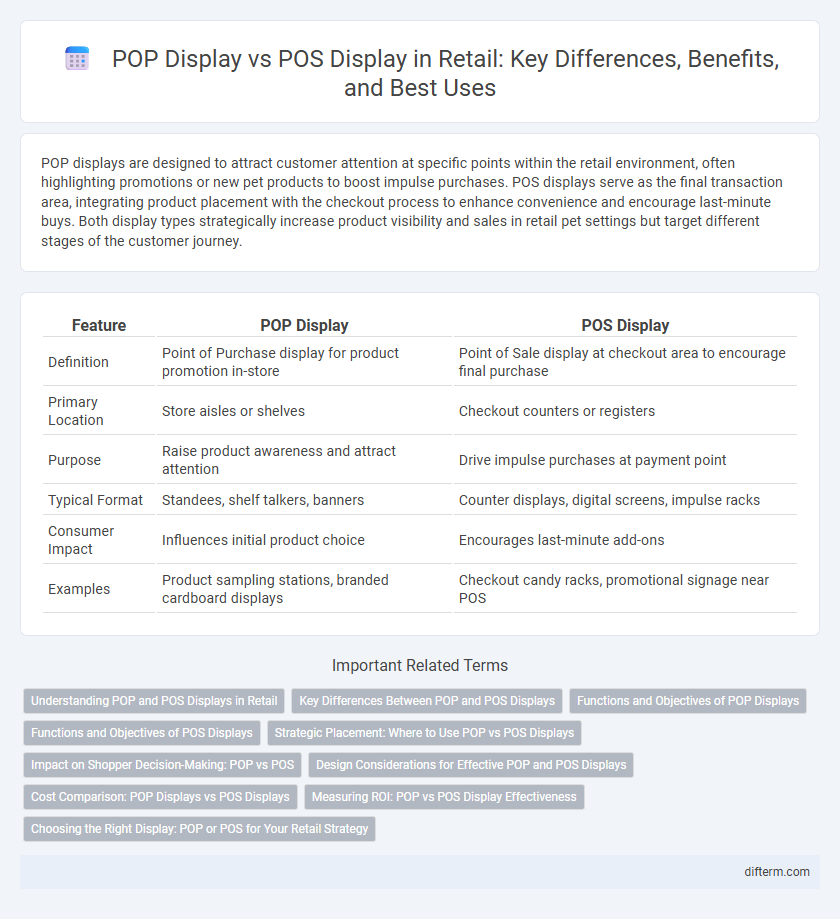POP displays are designed to attract customer attention at specific points within the retail environment, often highlighting promotions or new pet products to boost impulse purchases. POS displays serve as the final transaction area, integrating product placement with the checkout process to enhance convenience and encourage last-minute buys. Both display types strategically increase product visibility and sales in retail pet settings but target different stages of the customer journey.
Table of Comparison
| Feature | POP Display | POS Display |
|---|---|---|
| Definition | Point of Purchase display for product promotion in-store | Point of Sale display at checkout area to encourage final purchase |
| Primary Location | Store aisles or shelves | Checkout counters or registers |
| Purpose | Raise product awareness and attract attention | Drive impulse purchases at payment point |
| Typical Format | Standees, shelf talkers, banners | Counter displays, digital screens, impulse racks |
| Consumer Impact | Influences initial product choice | Encourages last-minute add-ons |
| Examples | Product sampling stations, branded cardboard displays | Checkout candy racks, promotional signage near POS |
Understanding POP and POS Displays in Retail
POP displays, or Point of Purchase displays, are marketing materials placed near the checkout area to encourage last-minute purchases, emphasizing product visibility and promotional messaging. POS displays, or Point of Sale displays, specifically refer to the hardware or digital systems used to complete sales transactions, such as cash registers and payment terminals. Understanding the distinction between POP and POS displays is crucial for retailers to effectively leverage merchandising strategies and improve customer experience at the point of sale.
Key Differences Between POP and POS Displays
POP (Point of Purchase) displays primarily aim to attract consumer attention and promote impulse buying by showcasing products prominently within the retail environment. In contrast, POS (Point of Sale) displays function at the checkout area, designed to encourage last-minute purchases and facilitate transaction efficiency. Key differences include their strategic placement--POP displays are often located in aisles or high-traffic zones, while POS displays are positioned at the cash register--and their focus on marketing impact versus transactional convenience.
Functions and Objectives of POP Displays
POP displays serve as strategic marketing tools designed to attract customer attention and promote impulse purchases directly at the product location within retail environments. Their primary functions include enhancing product visibility, showcasing key features and benefits, and encouraging quick buying decisions through eye-catching design and placement. Unlike POS displays, which integrate transaction processing elements, POP displays focus solely on driving product engagement and boosting sales through visual merchandising techniques.
Functions and Objectives of POS Displays
POS displays are designed to enhance the checkout experience by increasing impulse purchases and promoting last-minute sales, strategically placed near the point of sale. These displays effectively showcase small, high-margin products, provide essential product information, and reinforce brand messaging at the critical moment of purchase. Their primary objective is to boost sales conversion rates and maximize revenue by capturing consumer attention when buying decisions are made.
Strategic Placement: Where to Use POP vs POS Displays
Strategic placement of POP displays typically targets high-traffic areas or endcaps to capture customer attention and stimulate impulse purchases. POS displays are most effective near the checkout counter, encouraging last-minute buying decisions by maximizing visibility at the point of payment. Optimizing these locations based on shopper behavior enhances product visibility and drives sales conversions.
Impact on Shopper Decision-Making: POP vs POS
POP displays strategically influence shopper decision-making by showcasing products at critical purchase points, enhancing impulse buying through visual appeal and product accessibility. POS displays function primarily as transaction hubs, often limited to payment processing but subtly reinforcing brand presence through signage and promotional materials. Effective retail environments integrate both POP and POS displays to maximize shopper engagement and conversion rates at different stages of the purchase journey.
Design Considerations for Effective POP and POS Displays
Effective POP and POS display design requires attention to product visibility, brand messaging, and shopper engagement; POP displays often emphasize eye-catching graphics and height to draw attention, while POS displays focus on convenience near checkout to encourage impulse buys. Materials should balance durability with aesthetics, using vibrant colors and clear typography to communicate promotions quickly. Placement strategies optimize foot traffic flow and maximize the impact on purchase decisions within retail environments.
Cost Comparison: POP Displays vs POS Displays
POP displays generally involve lower initial production costs due to simpler design and materials, making them a cost-effective option for short-term promotions. POS displays, while more expensive to produce because of integrated technology and durability standards, offer higher long-term value by enhancing customer experience and driving sales conversion. Analyzing total cost of ownership reveals POP displays excel in budget-constrained campaigns, whereas POS displays justify investment through impact and reusability.
Measuring ROI: POP vs POS Display Effectiveness
Measuring ROI for POP displays involves tracking direct consumer engagement and impulse purchases at the point of purchase, highlighting visual appeal and product placement impact. POS displays focus on transactional data and sales lift during checkout, linked to promotional campaigns and brand visibility. Comparing effectiveness requires analyzing conversion rates, average transaction values, and customer interaction metrics for both display types to optimize marketing spend.
Choosing the Right Display: POP or POS for Your Retail Strategy
Choosing the right display for your retail strategy hinges on understanding the distinct roles of POP (Point of Purchase) and POS (Point of Sale) displays. POP displays are designed to attract customers' attention and encourage impulse purchases within the shopping area, often placed strategically near product aisles or checkouts. POS displays, meanwhile, focus on streamlining the final transaction process, serving as functional setups for cash registers and customer interactions to enhance checkout efficiency and overall sales experience.
POP Display vs POS Display Infographic

 difterm.com
difterm.com